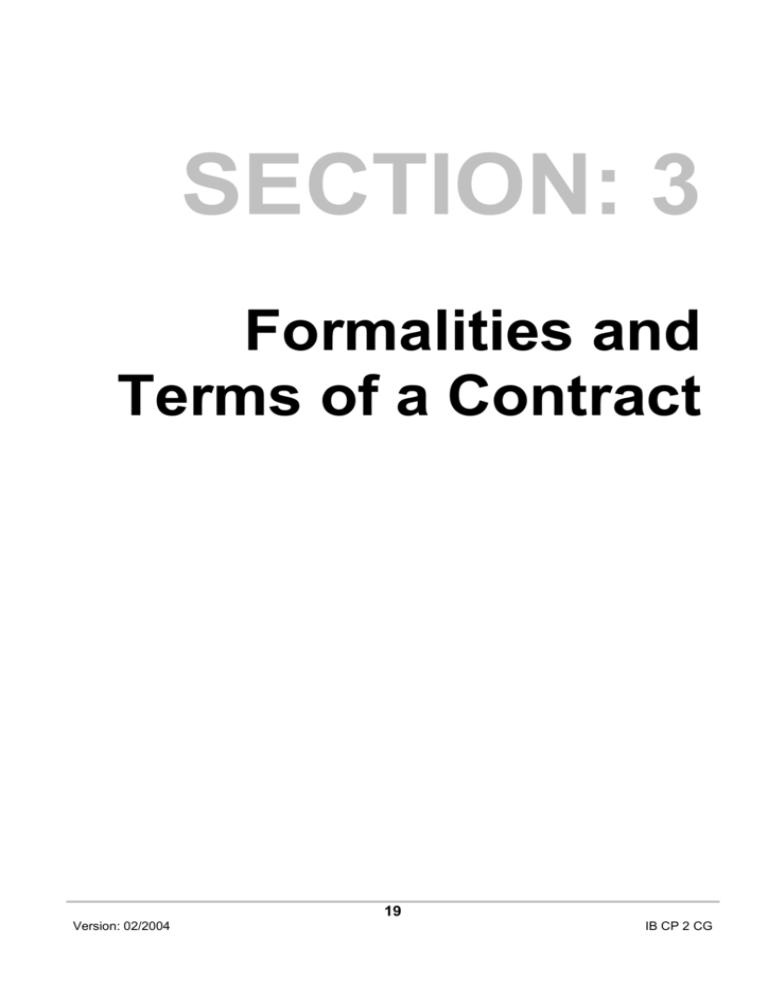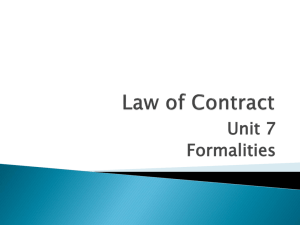3 - BankSETA
advertisement

SECTION: 3 Formalities and Terms of a Contract 19 Version: 02/2004 IB CP 2 CG TABLE OF CONTENTS Content Section 3 Formalities and Terms of a Contract Page 19 Overview 21 3.1 22 Assisting the Learners with this Section 20 Version: 02/2004 IB CP 2 CG Overview Learning Outcome The following is the Learning Outcome of this Section: 3. Conceptualise the Formalities and Terms of a Contract. Learning Objectives The Learning Objectives are as follows: On completion of this Section, the Learner must be able to: 3. Assessment Criteria Conceptualise the Formalities and Terms of a Contract by: Recognising Contracts where formalities are required Comprehending the terms of a Contract Comprehending the conditions of a Contract Comprehending the different clauses of a Contract To demonstrate the achievement of the Learning Objectives, Learners are required to meet the criteria and/or provide the following evidence: List Contracts that include formalities required by law Describe formalities included by parties to a Contract Identify the terms of a Contract Differentiate between express and implied terms Differentiate between a resolutive and a suspensive condition Differentiate between a supposition and a modus List the clauses that may form part of a Contract 21 Version: 02/2004 IB CP 2 CG 3. Formalities and Terms of a Contract 3.1 Assisting the Learners with this Section Overview of the main concepts of this Section This Section introduces the Learner to the formalities and terms of a Contract. To determine whether a valid Contract has come into existence, one needs to establish whether compliance with any formalities is prescribed for the formation of a particular type of Contract. Formalities are requirements relating to visible form in which the agreement must be cast in order to create a valid Contract. These requirements may be predetermined by the law or by the Contracting parties themselves. In most cases, compliance with formalities consists of reducing the Contract to writing with or without the signatures of the parties. The conditions of a Contract as well as the clauses that could form part of a Contract are discussed. Summary of key learning points Below is a summary of the key learning points of this Section. Formalities are requirements relating to visible form in which the agreement must be cast in order to create a valid Contract In the majority of cases, an informal Contract is binding and Contracts are validly concluded without the observation of any formalities The law requires that certain Contracts must be in writing, namely: Contracts for the alienation of land Contracts of Suretyship Contracts of donation in terms of which performance is due in the future Any credit agreement must be in writing and signed by or on behalf of every party thereto The parties to a Contract may themselves prescribe formalities The terms in a Contract imposes on a Contracting party obligations to: Act in a specific manner Refrain from performing a specific act Qualify the contractual obligations Terms are statements which are made seriously and deliberately and with the intention that they should be enforceable in law Terms may be imposed on a person, for example the terms that a bank imposes on all applications for loans or credit The person who wants to impose special terms in a Contract should ensure that the other party is made aware of the terms 22 Version: 02/2004 IB CP 2 CG 3. Formalities and Terms of a Contract Summary, continued Any Contract contains terms that are deliberately stated A condition is a particular kind of term and does not include all the terms generally found in Contracts A suspensive condition is a contractual term which suspends the operation of the contractual obligations in terms of the Contract until the condition has been fulfilled A resolutive condition is a contractual term which renders the continued existence of the Contract dependent on the occurrence (or nonoccurrence) of a specified uncertain future event The terms which render the existence of the Contract dependent on an event which has already taken place, or on a state of affairs which exists at the time of concluding the Contract, is known as a supposition (belief or assumption) A modus is a contractual term which burdens a Contracting party’s right to the performance made to him/her in terms of the Contract There are 5 types of clauses that could be included in a Contract, namely: 1. 2. 3. 4. 5. The Cancellation Clause The Penalty Clause The Forfeiture Clause The Rouwgeld Clause (Rouwkoop Clause) The Entrenchment Clause 23 Version: 02/2004 IB CP 2 CG 3. Formalities and Terms of a Contract Summary, continued There are four types of mistakes which will not make a Contract “voidable": 1. Mistake of Law. 2. Mistake of Motive. 3. Mistake of Expression. 4. Mistake as to Quantity. Misrepresentation can take one of four forms, namely: Things which are said Things which are not said Things which are done (also referred to as designed concealment” by one of the parties Things which are not done (e.g. deliberate omissions designed to mislead the other party) Types of misrepresentation are: Fraudulent misrepresentation Negligent misrepresentation Innocent misrepresentation Duress can be defined as an unlawful threat of harm or injury, made by a party to the Contract or someone acting on his/her behalf that causes the other party to conclude a Contract Undue influence may be defined as any improper or unfair conduct by one of the Contracting parties by means of which the other party is persuaded to conclude a Contract contrary to his/her independent will 24 Version: 02/2004 IB CP 2 CG 3. Formalities and Terms of a Contract Content covered in the Learner Guide The following is covered in this Section of the Learner Guide. Included is a list of topics as well as the page numbers relevant to the Learner Guide. TABLE OF CONTENT Content Page Outline of the Learning Outcomes and Objectives covered in this Section 62 Contracts where formalities are required Introduction The general rule Formalities required by law Credit agreements Formalities required by parties 63 63 63 64 64 65 Terms of a Contract Introduction Terms and statements Special/important terms Express and implied terms 66 66 66 67 70 Conditions of a Contract Introduction Suspensive conditions Resolutive conditions Supposition Modus 71 71 72 73 75 76 Clauses of a Contract Introduction The cancellation clauses The penalty clause The forfeiture clause The Rouwgeld clause The entrenchment clause 77 77 77 77 79 79 79 Summary 81 25 Version: 02/2004 IB CP 2 CG 3. Formalities and Terms of a Contract Activities covered in the Learner Guide The following activities are covered in this Section of the Learner Guide. Page Activity 63 Reflection activity: Self-explanatory. 65 Activity: The Learner needs to list all the Contracts in his/her work environment that must adhere to all the formalities as discussed on pages 64-65. 69 Activity: Self-explanatory. The Learner needs to note the procedure when explaining the terms and conditions of a credit agreement, lease or loan to a client before he/she signs the Contract. 70 Activity: The Learner needs to list 2 examples of Contracts that contain “express and implied terms”. 74 Activity: The Learner needs to note 2 examples of Contract in which resolutive and suspensive conditions are contained. 75 Activity: The Learner needs to investigate whether a supposition can be applied within THE BANK and list 2 examples of Contracts in which such a condition is contained. If not, he/she needs to motivate his/her answer. 76 Activity: The Learner needs to investigate whether a modus can be applied within THE BANK and list 2 examples of Contracts in which such a condition is contained. If not, he/she needs to motivate his/her answer. 80 Activity: The Learner needs to investigate whether any of the clauses are included in Contracts in THE BANK. The Learner needs to list the Contract and the clause(s) included in the Contract. 82 Activity: Self-explanatory. The Learner needs to note additional learning points or draw a mind-map of the learning points in the space provided. 26 Version: 02/2004 IB CP 2 CG








